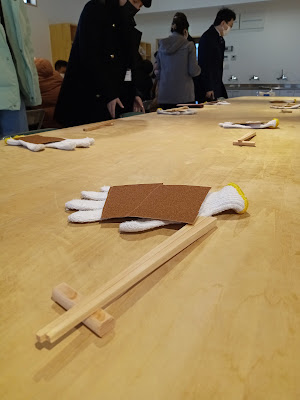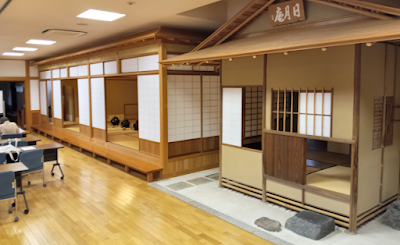Day 10, Literature & Norinaga (Matsuzaka, 'mono no aware'), local dialects, priestly forms
The day began with lessons on Ise's own accents and vocabulary in the past and still today. The second subject was the literature of Kokugaku and one of its most prominent champions, born only a short distance from Ise in the city of (today) Matsuzaka. Thanks to Motoori Norinaga, the ideas from the Genji Monogatari (mono no aware) have gained prominence, along with the methodology of using one ancient source to get insight into another one (reading Kojiki to understand Man'yoshu and vice versa, for example). The Edo-period magazines and books on display at the front of the room added a special vividness to the discussion.
 |
| looking closely at long-ago publications |
In the same powerful way that touch makes the subject easier to grasp for literature, the afternoon of observing, then talking about ritual processes and forms which priests in training practice once a week during all four years of college made a big impression on everyone. The reality of the priestly work became more vivid when dressing in the clothing for performing rituals, too.
Some of the questions and answers made the work of a Shinto profession come into better focus, too. <>A shrine has no intrinsic limit on how many kami are connected (one or multiple; the main one is the shusaijin, 主祭神). <>When priests are scarce, it is possible for one to conduct rituals that apply to multiple sites at the same time (go shi, 合祀). <>When priests behave badly, there is a process to remove their credential. <>Colors of ritual clothing are chosen by avoiding colors forbidden for certain occasions, and also may depend on rank/seniority. <>Some events call for multiple priests, but other times one is enough. <>In times of emergency, when no formal elements/clothing is at hand, then a priest can still lead a prayer (some forms of prayer are fixed, but other ones or parts of ones fit the person or situation). <>Prayers often are for happy occasions but also can be composed for serious or unhappy times. <>Rituals at shrines are most frequent or common, but jichinsai at a building site or the prayers for Japan's JAXA space launch can bring the ritual into the outdoors. <>Spontaneous times of joy or discovery of an impressive tree or boulder and other natural sources of wonder may elicit a prayer or it could spark a poetry recitation (Waka). <>Regional variation and line-up of available rituals is largely uniform after the national pressure to split Shinto from Buddhism and so on. But local traditions of a particular shrine can still be sustained above and beyond the forms taught at the seminaries.
Remaining questions: <>What thoughts or point of focus is inside a priest's mind or heart while officiating. <> What is the same as 100 or 500 years ago, and what is different about people's lives, about the kami, about harm to the natural environment. <>As one gains spiritual depth or growth, how do the rituals feel or function differently for priests? <>How do kami relate to priests differently to relating to non-priests.
Although it is a long stretch of the imagination: how do priests see Shinto filtered into daily life and habits of people? For example, can the careful presentation of the housekeeping staff when making beds also be in harmony with Shinto love of precision and deliberate forms of expression during rituals, I wonder. Or maybe the causation moves in both directions: Shinto priorities and values lead to similar habits of engaging in the social landscape and everyday spaces for work and home, but at the same time the lived experience of being organized, neat, fresh, attuned to proper form is part of the reason that Shinto rituals take the shape they now have so as to fit the larger cultural logic.
 |
| careful setting of pillow and sheets in hotel rooms |



Comments
Post a Comment